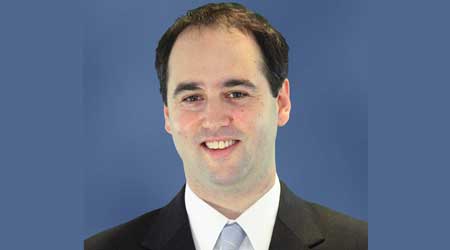Washington update 2019: What will a new and divided Congress mean for rail?

(Source: Progressive Railroading February 2019)
By Julie Sneider, Senior Associate Editor
Passing a permanent extension of the 45G short-line tax credit. Maintaining existing truck size and weight restrictions. Introducing a comprehensive infrastructure package that includes funding priority for freight and passenger rail. Shoring up the federal Highway Trust Fund. Continuing existing “balanced” regulations for freight railroads.
Those are the legislative priorities that rail industry advocates and trade association officials say they plan to spend much of their time talking about on Capitol Hill this year. While 2019 brings with it a new session of Congress — the 116th — all those priorities are perennial topics.
There are also some newer concerns that rail execs, advocates and lobbyists want to talk to lawmakers and congressional staff about, including precision scheduled railroading (and potential monitoring of), automation (and potential regulation of) and China’s state-owned enterprises (and regulation of).
This new session of Congress also means new faces — especially in the House, where Democrats reclaimed the majority in the November 2018 midterm elections. And, last month the House and Senate committees that deal with transportation legislation announced their new leadership.

“We think it’s about time that we had a predictable, dedicated source of funding for passenger rail.”Jim Mathews, president and CEO, Rail Passengers Association
In the House, U.S. Rep. Peter DeFazio (D-Ore.) was elected chairman and U.S. Rep. Sam Graves (R-Mo.) was named ranking member of the Transportation and Infrastructure Committee (T&I). U.S. Rep. Dan Lipinski (D-Ill.) now chairs the T&I Subcommittee on Rail, Pipelines and Hazardous Materials, while Rep. Rick Crawford (R-Ark.) is the subcommittee’s ranking member.
On the Senate side, Sen. Roger Wicker (R-Miss.) is chairing the Commerce, Science and Transportation Committee, with Sen. Maria Cantwell (D-Wash.) serving as its ranking member. The Subcommittee on Surface Transportation and Merchant Marine Infrastructure, Safety and Security is being chaired by Sen. Deb Fischer (R-Neb.), with Sen. Tammy Duckworth (D-Ill.) the ranking member.
Rail association representatives say they’ve already put their game plan into play to bring new members and congressional staffers up to speed on all things rail.
“A huge amount of education is needed,” says Chuck Baker, who became president of the American Short Line and Regional Railroad Association (ASLRRA) on Feb. 4. “There will be briefings on the Hill and — like every other industry — we will have to compete for lawmakers’ attention.”
Luckily, rail is relatively easy to understand — it’s a physical asset that can be talked about, says Baker, who previously was a partner at Chambers, Conlon & Hartwell LLC and president of the National Railroad Construction & Maintenance Association.
“A lot of these new members are interested in infrastructure, so we think we’ll have a friendly playing field,” he says.
Some of that education is already taking place, with more to occur during Railroad Day on Capitol Hill, which this year will be held May 8. And No. 1 on most rail advocates’ agenda for discussion is Section 45G. Since 2005, the measure has provided a tax credit of 50 cents for each dollar short lines and regionals spend on track and bridge improvements, capped at $3,500 per mile. The credit has been extended over the years and last expired Dec. 31, 2017.
Another go at the BRACE Act
Freight-rail advocates and the ASLRRA have aggressively campaigned for a permanent extension — and came very close to achieving that goal late last year. Legislation known as the Building Rail Access for Customers and the Economy (BRACE) Act — which proposed a permanent extension of 45G — wasn’t included in last year’s Tax Credit and Jobs Act. Although the proposal was included in a tax measure passed by the House in late December 2018, the measure didn’t pass the Senate.
But ASLRRA officials remain encouraged about 45G’s chances. On Jan. 11, U.S. Rep. Earl Blumenauer (D-Ore.) introduced H.R. 510, which calls for the credit’s permanent extension. The bill, which was referred to the House Ways and Means Committee, also is known as the BRACE Act in the new Congress, says Jerry Vest, Genesee & Wyoming Inc.‘s senior vice president of government and industry affairs.
Vest — who chairs the ASLRRA’s Legislative Policy Committee — believes the BRACE Act stands a good chance of passing Congress in part because of 45G’s history of strong, bipartisan support in both houses. As of press time, the House bill already had 42 co-sponsors and, on Jan. 24, a nearly identical bill (S. 203) had been introduced in the Senate. The tax credit, which has enabled short lines to invest $4 billion in their rail infrastructure since its inception, has been extended by overwhelmingly bipartisan votes on five previous occasions, according to the ASLRRA.
Still, Vest says the association will take “nothing for granted” on the legislation — especially with so many new members in Congress.
“This bill is our big deal and we’ll be working hard to get co-sponsors,” he says. “And we’ll be aggressively looking at getting the language incorporated into a revenue or tax bill that moves through Congress.”
Not only is the BRACE Act a big deal for short lines, it’s also important to the suppliers, contractors and subcontractors who do business with small railroads.
“Getting the 45G tax credit extended is our immediate priority,” says Jacob Carter, government affairs manager for the Railway Engineering-Maintenance Suppliers Association (REMSA). “It’s critical for our entire membership. The No. 1 thing I hear about is how much business goes through the roof once the tax credit goes through Congress.”
As for other legislative issues, REMSA and other rail-related trade groups will be keeping a close eye on any attempt by the trucking industry to convince Congress to increase the weight and size limit of trucks allowed on the nation’s highways. As the Association of American Railroads (AAR) describes it: “Any increase in truck size or weight limits — including 91,000 pound trucks or twin 33-foot double trailers — would foist more costs on to taxpayers because larger trucks would result in greater damage to infrastructure.”
Congress should maintain “reasonable” limits on truck size on interstates at 80,000 pounds in weight and no more than two 28-foot trailers in total length, AAR says on its website.
“A coalition of truck advocates that we constantly monitor are focused on increasing truck size and weight limits,” says Carter. “What they keep doing is passing pilot programs throughout the country to test out larger trucks and that’s something we are concerned about.”
As more states allow such tests, freight-rail groups remain “on defense” to ensure that higher limits are not made permanent at the national level, Carter says.

“We plan to ask the [House committee] chairmen to support a GAO study that would look at how the USDOT is enforcing Buy America throughout its agencies.”Nicole Brewin, VP of government affairs, Railway Supply Institute
Other policy topics of interest to railroaders this year include competition from state-owned enterprises and U.S. enforcement of its Buy America provisions, according to Nicole Brewin, vice president of government affairs at the Railway Supply Institute (RSI).
Some lawmakers have begun paying attention to suppliers that are primarily owned by foreign governments, such as the China Railway Rolling Stock Corp., which has been using low bids to win an increasing number of U.S. transit-car contracts. U.S.-based suppliers want federal agencies to pay closer attention to enforcing the Buy America Act, says Brewin.
“We hear that [T&I Chairman] DeFazio and [rail subcommittee Chair] Lipinski are looking at having a committee hearing on China and state-owned enterprises and how Buy America is being impacted. We are very interested in seeing how that unfolds,” says Brewin. “We plan to ask the chairmen to support a GAO [Government Accountability Office] study that would look at how the U.S. Department of Transportation is enforcing Buy America throughout its agencies.”
Along the line of potential rail industry regulation, Brewin has heard rumblings that congressional hearings also may be held on such topics as precision scheduled railroading, automation and innovative technologies in transportation. And at Railroad Day on the Hill, rail industry associations plan to talk to lawmakers and Hill staffers about new rail technologies, particularly those that help promote safety, she says.
RSI and other rail supplier representatives also plan to talk up their 2018 report highlighting their industry‘s impact on the U.S. economy.
Released by REMSA, RSI, Railway Systems Suppliers Inc. and the Railway Tie Association, the report found that the rail supply industry’s economic contribution in 2017 amounted to more than $74.2 billion in GDP and $16.9 billion in taxes to local, state and federal governments.
“We are a big contributor to the U.S. economy and have members in 47 states. That’s a message we want to communicate to Congress,” Brewin says.
Wishing for a funding package
Regardless of whether they represent suppliers, contractors or railroads, rail advocates say a major transportation infrastructure investment will be near the top — if not at the top — of their legislative wish-list for 2019.
A year ago, rail groups were anxiously waiting for President Trump’s long-promised plan to “rebuild the nation’s crumbling infrastructure” — a proposal that ultimately didn’t pass Congress. At the time, rail industry reps hoped to convince legislators to prioritize rail projects for funding in an infrastructure bill.
This year, rail advocates will again push for federal funding of rail programs and projects as part of a major infrastructure package, which could come in the form of surface transportation reauthorization of the Fixing America’s Surface Transportation (FAST) Act of 2015. That legislation will expire at the end of September 2020, so work on renewing the FAST Act should gear up this year, advocates say. T&I Chair DeFazio already has indicated he wants that to happen.
To no one’s surprise, how infrastructure investment should be funded — in the form of a separate bill or as part of FAST Act reauthorization — is expected to be the main focus of debate. Ensuring there’s funding for rail — including for Amtrak and its Gateway/Hudson River tunnel construction projects — will be essential to any infrastructure package, rail supporters believe.
Along those same lines, fortifying the Highway Trust Fund (HTF) and its Mass Transit Account will be part of the discussion. Paying for it and other infrastructure programs is likely to set off deliberations over whether to raise the federal gas tax — which funds the HTF — or seek other revenue models, such as a general sales tax, a vehicle miles traveled fee or a per-barrel tax on crude oil.
“We are not in a place where we can keep relying on the same funding model,” says Jim Mathews, president and CEO of the Rail Passengers Association (RPA). “We would like Congress to look at a variety of funding options, mostly around a passenger-rail trust fund. We think it’s about time that we had a predictable, dedicated source of funding for passenger rail.”
Mutual agreement on Amtrak — or anything?
A lot of RPA’s policy issues center on all things Amtrak. To that end, the RPA will be calling for Congress to help address Amtrak’s on-time performance problem by establishing a charter for a Shared-Use Corridor Advisory Committee to develop new “mutually satisfactory solutions” on Amtrak’s shared use of rail corridors with the Class Is, says Mathews.
The way RPA envisions it, the committee would be similar to the Railroad Safety Advisory Committee, which uses a collaborative process involving all segments of the rail community to find mutually agreeable solutions to safety regulatory issues.
Whether members of Congress can agree on any policy or legislation in these days of hyperpartisanship remains to be seen. Some rail advocates used words like “negative,” “frustrating” and “gloomy” to describe the political climate in Washington, as the government was mired in a partial shutdown for five weeks between December and January.
“The mood is terrible,” said one rail lobbyist, as the shutdown wore on. “The well has been thoroughly poisoned.”

“We’re not yet at a point where [Congress] won’t do anything, and infrastructure and surface transportation is one area that people can work on together.”Chuck Baker, president, American Short Line and Regional Railroad Association
Also expected to add to the political tension on the Hill is the 2020 presidential election cycle, which already is ramping up. Still, every day is a new day — and a new chance to talk with lawmakers about railroading, industry advocates say.
“We’re not yet at a point where [Congress] won’t do anything, and infrastructure and surface transportation is one area that people can work on together,” says the ASLRRA’s Baker. “We need to get back to those kinds of discussions.”
Adds REMSA’s Carter: “It is a very divided Congress. But, we make the argument that investing in railroads is not a political issue. It’s good for urban and rural communities and their economies. It’s something that’s good for everyone — and that makes it a rare bipartisan issue.”
Email comments or questions to julie.sneider@tradepress.com.
